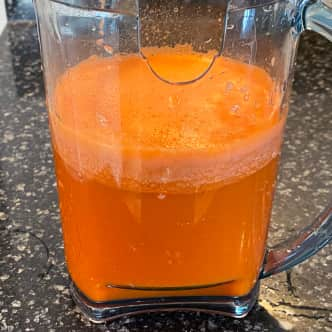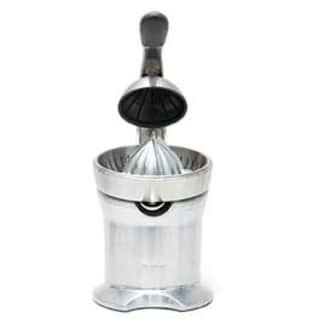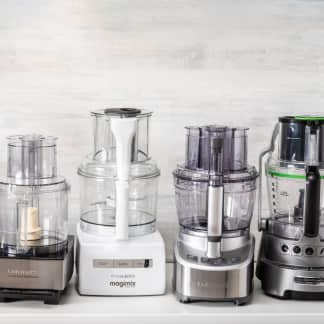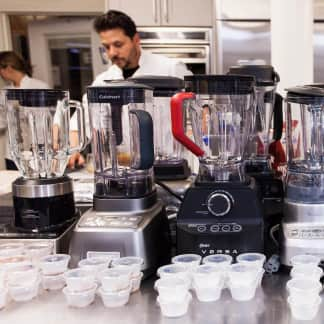Juicing at home saves money, allows more control over juice ingredients, and can be more convenient than buying premade juice—if you invest in the right juicer. To find the best model, we assembled a lineup of nine juicers, priced from about $69 to about $450, and put them to the test, juicing more than 95 pounds of carrots, kale, and grapes. We evaluated how easy they were to assemble and operate, their speed and efficiency, the quality of their juice, and how simple they were to clean and maintain. We were looking for a speedy, efficient model that produced great-tasting juice.
All juicers work in roughly the same way: They process fruits and vegetables into pulp and then force the pulp through a fine filtration screen, leaving the solids behind and creating, well, juice. The two main types of juicers—centrifugal and masticating—process produce differently. Both types have their pros, cons, critics, and devotees, and it’s important to know the differences before buying one. To get a full picture of what’s available to consumers, we tested both types.
Centrifugal Juicers
Centrifugal juicers process produce by using a shredding disk (similar to that of a food processor), which is housed in a finely perforated filter basket. As the food is shredded into pulp, the spinning disk flings the pulp against the sides of the filter basket. The centrifugal force separates the juice, which is dispensed into one container, from the pulp, which is deposited into a second container. Centrifugal juicers are known for being relatively inexpensive and fast. But their swiftly spinning blades and powerful motors have given them a reputation for heating produce and introducing too much air, purportedly creating slightly warm, frothy juice.


During testing we found the centrifugal juicers to be powerful and loud. Some models wobbled and walked on the counter as they processed food, sometimes coming dangerously close to the edge of the sink or counter. And they were often messy: Some machines flung food from their feed tubes and onto our kitchen surfaces (and ceiling). They also don’t always perform well with lighter foods or leafy greens (for tips on how to get the best results, see "How to Get the Most Out of Your Centrifugal Juicer" below). But they can accommodate a lot of food at once; the models we tested have 3-inch-wide feed tubes that fit whole carrots, small apples, or entire leaves of kale, which eliminated the need for food prep. And they’re fast: Every centrifugal model in our lineup powered through a pound of carrots (about six carrots) in less than 50 seconds, with the fastest clocking in at 34 seconds.
Masticating Juicers
Masticating juicers (also called “slow” or “cold-press” juicers) don’t have sharp blades. Instead, they use a spinning screw-shaped press called an auger to grind produce into pulp and force it through a fine-mesh filtration screen, squeezing out the juice. Masticating juicers can be horizontal or vertical; the only difference between them is the placement of their motors and the direction the produce travels in their juicing chambers. Masticating juicers are slow by design. Some avid juicers contend that slowly crushing and pressing produce—rather than quickly shredding and spinning it—causes less oxidation of nutritious compounds in the juice. Several studies have compared the nutritional content of juices from both types of juicers, with inconclusive results.


We found the masticating juicers to be quieter; more stable on the counter; and, indeed, slower than centrifugal juicers. The augers can jam if too much food is inserted at once, so their feed tubes are usually smaller in diameter—about 1½ inches. This meant that we had to do more prep work, splitting carrots lengthwise and cutting kale into 1-inch pieces. It was easy to insert too much food at once and gum up the works. It took about 1 minute and 47 seconds on average to juice a pound of carrots with the masticating juicers, as opposed to an average of about 39 seconds with the centrifugal juicers. The fastest masticating model juiced a pound of carrots in about 1½ minutes. And they were less messy than the centrifugal models; no debris escaped the feed tubes.
Juicing Effectiveness
Most important, which type of juicer made the best juice most efficiently? To determine whether the models in our lineup could handle dense, leafy, and soft produce alike, we juiced a mountain of carrots, lacinato kale, and seedless red grapes. We weighed out a pound of each type of produce per machine and then weighed both the resulting pulp and juice to determine each juicer’s efficiency. We noted the moisture left behind in the pulp—a marker of how well each juicer was doing its job—and we evaluated the consistency and taste of the juice.
We expected one style of juicer to be more efficient than the other overall, but that didn’t happen. Centrifugal juicers were slightly better at juicing carrots, producing an average of 7.9 ounces of juice compared to the masticators’ average of 6.5 ounces. Centrifugal juicers’ efficiency with denser foods such as carrots comes down to their shredding method, which disrupts the plant tissue more thoroughly than crushing and makes more juice available. But the centrifugal models really struggled to process leafy, fibrous kale; their blades often missed large pieces of kale entirely, flinging them almost whole into the pulp bins and only creating about 2.8 ounces of juice per pound of kale on average. The masticating juicers were able to squeeze juice from the leaves more effectively, producing an average of 5.6 ounces of juice per pound of kale. Masticating juicers were also slightly more adept at juicing grapes. They produced 11 ounces of grape juice per batch on average, compared to the centrifugal juicers’ 9.2 ounces.

The kale juices produced by the masticating juicers were often thick—almost like a kale milkshake.
There were no differences in juice flavor or freshness between juicer styles—both made great juice. But we didn’t always notice trends in juice consistency based on the type of juicer. The kale juices produced by the masticating juicers were often thick—almost like a kale milkshake—while kale juices produced by the centrifugal juicers were often thinner and silkier. But the patterns stopped there. The consistencies of the carrot juices varied widely, from gritty to smooth, regardless of the juicer type. The same was true for the grape juices, which were sometimes pulpy and other times clear. Some models produced smooth juice from some produce and gritty juice from others, seemingly without patterns—even though we standardized produce sources and temperatures. And despite centrifugal juicers’ reputation for creating foamy juice, our tests revealed that all the juicers in our lineup produced juice with varying amounts of foam, which was initially unpleasant but dissipated somewhat within a few minutes.
How to Get the Most Out of Your Centrifugal Juicer
- Speed Matters: You should process softer or lighter produce such as leafy greens or tomatoes on slow speed, or they'll fly right into the pulp bin.
- Size Matters: The larger your pieces of produce are, the better. Whole tomatoes, whole (cored) apples and pears, and big leaves of kale will process better than small chopped pieces.
- Bundle Greens: Pack leafy greens into a tight bundle, and really pack the feed tube full before juicing. You can also roll leaves up like a cigar, layering small leaves inside bigger ones.
- Layer Ingredients: Add foods in a specific order to get the most out of them. Add leafy vegetables first, then root vegetables, then pulpy or heavy foods on top, which will weigh things down so they process better. If you have small pieces of ginger or lemon, feed them through earlier so the other food pushes them through, or they could get lost.
Debunking Juicer Myths
As we juiced, we considered two claims people often make about juicers: that centrifugal juicers create warm juice and that the juice produced by masticating juicers stays fresher longer because the machines crush rather than shred produce, preventing oxidation. To see if these claims were true, we measured the internal temperature of the carrots before we juiced them and then measured the temperatures of the juices. Centrifugal juicers did not produce notably warmer juice than their masticating counterparts; all temperature changes were within 3 degrees. We also stored 1 cup of carrot juice from each juicer in the refrigerator for four days, photographing and tasting them every day. All the juice samples dulled in flavor and darkened in color over the four days, but there were no notable differences in taste between juicer types. Some people like making and storing larger batches of juice, but based on how the flavors of our samples changed, we don't recommend storing juice for longer than two days regardless of which style of juicer you use.

Assembly And Cleaning
No matter which type of juicer you choose, juicing is a messy, sticky business. All the models have to be disassembled and thoroughly cleaned after each use. Some juicers were straightforward to take apart and put together, with components that fit together easily and quickly. Other models were stubborn when we tried to take them apart, especially when filled with pulp, which seemed to cement their parts into place. It often took forceful pulling to detach certain parts. And reassembling some models after cleaning them was tedious; their pieces often refused to cooperate and fit together well.




Those looking for an easy-to-clean juicer are out of luck. After enduring dozens of juicer-scrubbing sessions, we can confidently say that every juicer in our lineup takes some elbow grease to clean thoroughly. Many of the manufacturers recommend soaking the filter baskets or filtration screens and include special scrub brushes; we found the juicers difficult to clean even when we followed their cleaning instructions. Their filtration screens’ tiny perforations trapped pulp and held on to it. The parts of some models were dishwasher-safe, but our dishwasher failed to dislodge pulp that was stuck in the filter baskets of three models, even after thorough prerinsing. And some of the juicers had nooks and crannies where pulp got clogged and took some digging and scouring to remove. In most cases, we had to break out our winning scrub brush to get the job done. We preferred juicers that were easier to assemble and disassemble and that we could scrub clean with only a bit of effort.

Winning Juicers: The Breville Juice Fountain Cold And Omega Vsj843 Qs Vertical Square Low Speed Juicer
Because each type of juicer has its pros and cons, we chose a winner in each category. Which juicer type is right for you? Centrifugal juicers are less expensive (usually between $50 and $200), faster, and more efficient with dense foods and require less food prep due to their wide feed tubes. However, they can be loud and messy, and they have a lot of trouble with leafy greens. We recommend them for people who are new to juicing, want to make only a moderate financial investment, and/or don't want to spend time cutting produce down to size. But it takes practice and a few tips to get a centrifugal juicer to perform optimally (see “How to Get the Most Out of Your Centrifugal Juicer,” above). Our winning centrifugal juicer, the Breville Juice Fountain Cold, is fast and efficient and creates smooth, fresh-tasting juice with ease, though its juice can be a touch foamy. While it can move on the counter a bit while in use, it kept pulp more contained than the other centrifugal juicers. It’s also relatively easy to assemble and clean. For those who are looking for a juicer that is quieter, less messy, and more efficient (especially when dealing with leafy greens), we recommend a masticating juicer—though they are more expensive, often running between $300 and $450. Our winner, the Omega VSJ843QS Vertical Square Low-Speed Juicer, is easy to assemble and operate and was the fastest masticating juicer; it was also among the easiest masticating juicers to clean. While its smaller feed tube calls for a little more food prep, it still takes less than 1½ minutes to juice a pound of carrots, and we loved its silky-smooth juice. Both these models are great options with different strengths and at two different prices, so all types of juice enthusiasts can find what they’re looking for.
- Straightforward assembly, with parts that fit together well
- Relatively fast, efficient juicing process
- Produces smooth, fresh-tasting juice
- Relatively easy to clean
- Test nine electric juicers (four centrifugal, five masticating), priced from about $69 to roughly $450
- Assemble the juicers, evaluating their ease of assembly
- Measure each juicer’s feed tube and cut carrots, kale, and grapes to match the feed tube size if necessary, taking note of whether additional prep is needed
- Time how long it takes to juice 1 pound of carrots
- Evaluate the carrot juice for temperature change
- Evaluate the carrot juice for flavor and consistency
- Juice 1 pound of kale, evaluating the juice’s flavor and consistency
- Juice 1 pound of red grapes, evaluating the juice’s flavor and consistency
- Store 1 cup of carrot juice for four days, evaluating its flavor and consistency each day
- Juice an additional 5 pounds of carrots to test durability
- Clean the juicers after every test by hand or in the dishwasher, according to the manufacturers’ recommendations, noting the ease of cleanup

























